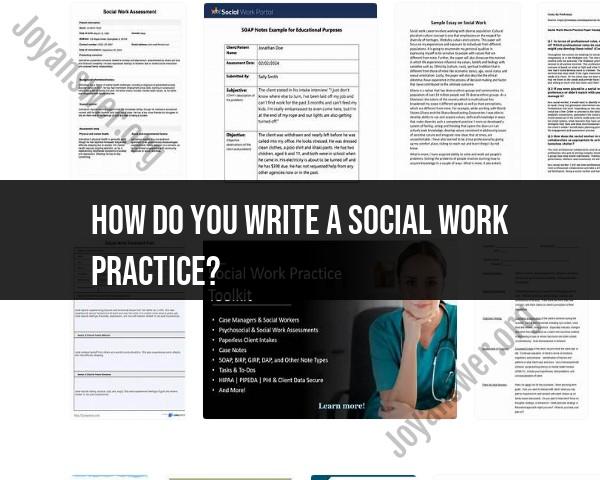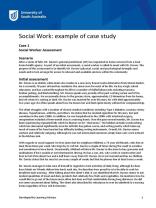How do you write a social work practice?
Writing a Social Work Practice Report involves clearly documenting your work with clients, interventions, observations, and outcomes. It’s a professional way to communicate the process and results of your social work practice to supervisors, colleagues, or agencies.
How to Write a Social Work Practice Report
1. Understand the Purpose
To record and reflect on the social work intervention or session.
To provide evidence of assessment, planning, intervention, and evaluation.
To help guide future work and ensure accountability.
2. Use a Clear Structure
Here’s a common structure you can follow:
Typical Sections in a Social Work Practice Report
A. Client Information
Name or ID (ensure confidentiality if needed)
Age, gender, relevant background
B. Purpose of the Report
Briefly state why the report is written (e.g., case update, intervention summary).
C. Presenting Issue
Describe the client’s main problems or reasons for seeking help.
D. Assessment
Summarize your evaluation of the client’s situation (social, emotional, physical, environmental factors).
Include observations, interviews, and any assessment tools used.
E. Intervention/Actions Taken
Detail the strategies or support you provided.
Mention referrals, counseling, advocacy, or other actions.
F. Client Response
How did the client respond to the intervention?
Any changes, progress, or setbacks observed.
G. Outcomes
What was achieved?
Goals met or unmet.
H. Plan/Recommendations
Next steps or ongoing plans for the client’s care.
Any referrals or follow-up needed.
I. Reflection (optional but recommended)
Your professional thoughts about the case.
Challenges faced and lessons learned.
J. Signature and Date
3. Use Clear and Professional Language
Be objective, factual, and avoid jargon.
Maintain confidentiality and use pseudonyms if necessary.
4. Keep it Concise but Detailed
Include enough detail to understand the situation without unnecessary information.
Example Opening Sentence
“This report summarizes the social work intervention provided to Client X, a 35-year-old female experiencing housing instability and mental health challenges.”
Sample Social Work Practice Report
Client Information:
Name: Jane Doe (pseudonym)
Age: 35
Gender: Female
Background: Single mother, recently homeless, diagnosed with anxiety disorder.
Purpose of Report:
This report documents the assessment and intervention provided to Jane Doe regarding her housing instability and mental health concerns.
Presenting Issue:
Jane presented with concerns about losing her housing and increased anxiety symptoms, including panic attacks and difficulty sleeping. She expressed fear about her and her children's safety.
Assessment:
During the assessment, Jane disclosed a history of domestic violence, which contributed to her current homelessness. She has limited family support and struggles to maintain steady employment due to her anxiety. Observations showed she was visibly distressed but cooperative.
Intervention/Actions Taken:
Provided crisis counseling focused on safety planning.
Referred Jane to a local shelter specializing in domestic violence survivors.
Assisted with the application process for housing support programs.
Coordinated with a mental health counselor for ongoing therapy.
Developed a follow-up plan for regular check-ins.
Client Response:
Jane engaged actively during sessions and expressed relief after safety planning. She accepted referrals and showed motivation to pursue therapy and stable housing.
Outcomes:
Jane was successfully admitted to a shelter within one week. She began therapy sessions and reported a slight reduction in anxiety symptoms during follow-up.
Plan/Recommendations:
Continue weekly check-ins to monitor progress.
Support Jane in securing permanent housing.
Coordinate with employment services to explore job opportunities.
Encourage participation in support groups for survivors of domestic violence.
Reflection:
This case highlighted the importance of a multidisciplinary approach to address both immediate safety and long-term stability. Challenges included limited shelter availability and Jane’s fluctuating mental health, requiring flexible intervention strategies.
Report Completed by:
[Your Name], Social Worker
Date: August 9, 2025
How to Write a Social Work Practice Report?
A social work practice report is a formal document that details a social worker's interactions and interventions with a client. To write an effective report, you need to be clear, concise, and objective. It should include an assessment of the client's situation, a description of the intervention strategies used, and an evaluation of the outcomes. The report should be factual, free of personal bias, and use professional language. It's crucial to document conversations, observations, and decisions accurately to create a reliable record of the case.
What Are the Objectives of Social Work Practice Documentation?
The primary objectives of social work documentation are to:
Ensure Continuity of Care: A well-documented report allows other social workers or professionals to quickly understand the client's history and the services provided, ensuring a smooth transition if the case is transferred.
Facilitate Communication: It serves as a central source of information for all parties involved in a client's care, including supervisors, other healthcare providers, and legal entities.
Provide Accountability: Documentation holds social workers accountable for their actions and decisions, providing a record of ethical and professional practice.
Support Legal and Administrative Functions: Reports are often used as evidence in legal proceedings or for justifying service provision to funding bodies and government agencies.
How to Structure Your Report for Clarity?
A clear and logical structure is essential for an effective social work report. A standard format includes:
Client Information: Basic details like name, date of birth, and contact information.
Reason for Referral: A brief explanation of why the client was referred for services.
Assessment: A detailed analysis of the client's situation, including their strengths, challenges, and needs. This section should be based on a recognized social work framework.
Intervention Plan: The specific goals and strategies developed with the client.
Progress Notes: Chronological entries detailing each interaction, conversation, and action taken.
Evaluation and Outcomes: An assessment of whether the intervention goals were met and a plan for future steps.
Recommendations: Suggestions for further action or resources.
What Are Common Challenges in Writing Practice Reports?
Social workers often face several challenges when writing reports:
Lack of Time: Heavy caseloads can make it difficult to dedicate sufficient time to detailed and accurate documentation.
Balancing Objectivity and Empathy: It's challenging to maintain a professional, objective tone while accurately capturing the client's emotional state and lived experience.
Jargon and Clarity: Using overly technical jargon can make the report difficult for other professionals to understand, while being too simplistic may fail to capture the complexity of a case.
Avoiding Bias: Social workers must be vigilant in ensuring their personal biases do not influence the language or content of the report.
How to Ensure Confidentiality in Reports?
Maintaining confidentiality is a cornerstone of social work ethics. To ensure it in reports:
Anonymize Where Possible: Use initials or a client ID number instead of a full name.
Limit Information to What Is Necessary: Only include information that is relevant to the case and the professional purpose of the report. Avoid extraneous personal details.
Secure Storage: Store all reports in a locked file cabinet or a password-protected, encrypted digital system to prevent unauthorized access.
Obtain Informed Consent: Always get the client's permission before sharing their information with other professionals, unless there is a legal or ethical obligation to disclose it.
Follow Agency Policies: Adhere strictly to your agency's and state's confidentiality policies and laws, such as HIPAA in the United States.












